
Overview
Elemento leads efforts to tailor treatments for individual patients’ diseases by deciphering their molecular roots with cutting-edge technologies.
Build healthcare systems’ capacity to deliver personalized medicine
Olivier Elemento, PhD, is at the forefront of a decades-long movement to build healthcare systems’ capacity to tailor the treatment of diseases to individual patients’ responses.
As head of the Englander Institute for Precision Medicine at Weill Cornell Medicine (WCM) since 2017, Elemento has led its efforts to decipher the molecular roots of individual patients’ diseases by applying cutting-edge technologies like high-content microscopy (advanced real-time, high-resolution imaging) and multiplex spatial imaging to tissue analysis.
Over the years, he has built a multidisciplinary staff of roughly 100 scientists and clinicians with expertise in pathology, molecular and computational biology, oncology and basic sciences. This enables them to break down rigid academic silos and integrate disciplines because, he says, precision medicine is about much more than DNA sequencing. These teams are achieving discoveries that are shaping how academic medical centers can improve patient care.
Since its inception in 2015, the Englander Institute has analyzed the drug responses of several thousand WCM patients, and it expects to undertake up to 1,000 more patients this year.
Elemento says that during the next five to 10 years, the Institute plans to scale its services with the goal of offering routine screening for all patients at WCM—so that precision medicine becomes “just medicine,” he says. While its initial focus has been on cancer, the Institute’s infrastructure applies to many disease areas, including cardiovascular, lung, neurological and metabolic diseases.
While Elemento’s team is making huge strides in precision medicine, he says that the Institute is battling the same challenges as everyone else in the field: attempting to figure out how to integrate extremely complex technologies into healthcare systems at reasonable costs and reproducible and accessible formats, enabling them to gain the medical community’s trust and make a meaningful impact on patients.
Individualizing Drug Screening at Scale
Elemento’s academic career in engineering and computational biology has given him the foundation for building a world-class, multidisciplinary translational research center focused on precision medicine. While engineering provided introductions to robotics, computer science and math, its applications were uninspiring, so Elemento looked for ways to get more involved with clinical care.
The Institute is a world leader in leveraging cutting-edge, customized technology that helps real-world understanding and mapping of every aspect of an individual patient’s disease. A custom-built robotic high-throughput drug screening platform systemically analyzes many disease types and uses 3D organoids (three dimensional aggregates of cells that can be used as diseases models to understand an individual’s disease behaviors) to assess individual responses to hundreds of drugs.
“No one else has that robot, which we assembled from parts from different vendors,” and the ability to grow and assess drug responses in tumor organoids from many cancers (instead of focusing on just one or two) are also differentiators, Elemento says. To date, Englander scientists have successfully grown at least 250 tumor organoids across 20 different types of cancers for screening for individual responses to drugs.
The tumor organoid and drug screening platforms together provide highly specific information on drug response critical to treatment over time as patients for whom therapies fail look for alternatives. A study of colorectal cancer patients found that screening for more than 150 drugs using organoids not only correlated accurately with 70 to 80 percent of actual patient response but also provided many other drug suggestions for treating patients.
The Institute uses a powerful imaging system that looks at individual cells in their natural tissue environment, giving researchers much more detailed and useful information. This technology has transformed biology by allowing scientists to study dozens of proteins and thousands of gene messages in single cells at the same time. New methods also let them examine these cells in the exact locations they appear in the tissue, helping to show how cells interact and are organized.
During the peak of the COVID pandemic, the Englander Institute was the first group to analyze lung tissue from patients with severe COVID, helping it to unravel the causes of severe lung damage in these patients. The same techniques are now being used in hundreds of patients with cancer, for projects ranging from predicting chemotherapy response based on cancer tissue composition and finding early lung lesions most likely to progress to aggressive lung cancer.
In late 2020, the Englander Institute was among the first to sequence the complete genomes of thousands of volunteers with the goal of naming genetic drivers of disease and evaluating the diagnostic potential of WGS in a real-world, high-volume setting. It is doing this work through a collaboration with New York-Presbyterian Hospital, Illumina and the New York Genome Center (NYGC). WGS has been shown to improve patient care in specific clinical contexts, but few healthcare systems have scaled it to use across multiple disease pathways.
Elemento has also pioneered new computational approaches, led by AI, to address some of the most pressing challenges of data analysis. Bringing clinicians from multiple specialties together to work on precision medicine initiatives is challenging both financially and professionally, but Englander’s institutional structure provides the environment and resources to encourage participation, Elemento says.
Integrating the research into the workflow of the medical clinic is critical but efficiency in such a complicated environment remains challenging. For example, collecting patient samples requires tight coordination and prompt retrieval of surgical biopsies to properly preserve fresh tissue, which can be difficult to coordinate.
Elemento’s next goal is to more systematically integrate the results of precision medicine screening into patients’ electronic medical records in ways that enable clinicians to interrogate the data. This effort is likely to require new visual approaches that are acceptable to physicians, says Elemento.
So far, health insurance doesn’t cover these efforts, and they are currently costly and require support from generous philanthropists—a situation that is likely to be the case for the foreseeable future, says Elemento.
Everyone is trying to work on that gap, with one argument being that using precision medicine tools to cut unnecessary treatment ultimately saves money for healthcare systems. But that’s costly to implement, and most systems do not have the funding to do it at a rate that generates profits. Another solution is to find new technologies that run testing at lower costs. And, ultimately, patients will have to get involved to convince payors to lower costs. Meanwhile, the work is crucial because, he says, “There is no such thing as an average patient. Each person is unique.”







